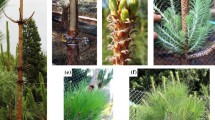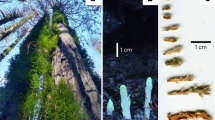Abstract
In frequently burnt mesic savannas, trees can get trapped into a cycle of surviving fire-induced stem death (i.e. topkill) by resprouting, only to be topkilled again a year or two later. The ability of savanna saplings to resprout repeatedly after fire is a key component of recent models of tree–grass coexistence in savannas. This study investigated the carbon allocation and biomass partitioning patterns that enable a dominant savanna tree, Acacia karroo, to survive frequent and repeated topkill. Root starch depletion and replenishment, foliage recovery and photosynthesis of burnt and unburnt plants were compared over the first year after a burn. The concentration of starch in the roots of the burnt plants (0.08 ± 0.01 g g−1) was half that of the unburnt plant (0.16 ± 0.01 g g−1) at the end of the first growing season after topkill. However, root starch reserves of the burnt plants were replenished over the dry season and matched that of unburnt plants within 1 year after topkill. The leaf area of resprouting plants recovered to match that of unburnt plants within 4–5 months after topkill. Shoot growth of resprouting plants was restricted to the first few months of the wet season, whereas photosynthetic rates remained high into the dry season, allowing replenishment of root starch reserves. 14C labeling showed that reserves were initially utilized for shoot growth after topkill. The rapid foliage recovery and the replenishment of reserves within a single year after topkill implies that A. karroo is well adapted to survive recurrent topkill and is poised to take advantage of unusually long fire-free intervals to grow into adults. This paper provides some of the first empirical evidence to explain how savanna trees in frequently burnt savannas are able to withstand frequent burning as juveniles and survive to become adults.






Similar content being viewed by others
References
Archibald S, Bond WJ (2003) Growing tall vs. growing wide: tree architecture and allometry of Acacia karroo in forest, savanna, and arid environments. Oikos 102:3–14
Balfour DA, Howison OE (2001) Spatial and temporal variation in a mesic savanna fire regime: responses to variation in annual rainfall. Afr J Range Forage Sci 19:45–53
Barnes RD, Filer DL, Milton SJ (1996) Acacia karroo: monograph and annotated bibliography. Oxford Forestry Institute, Oxford
Bernhard-Reversat F (1982) Biogeochemical cycle of nitrogen in a semi-arid savanna. Oikos 38:321–332
Bond WJ, Archibald S (2003) Confronting complexity: fire policy choices in South African savanna parks. Int J Wildl Fire 12:381–389
Bond WJ, Midgley GF (2000) A proposed CO2-controlled mechanism of woody plant invasion in grasslands and savannas. Glob Chang Biol 6:865–869
Bond WJ, van Wilgen BW (1996) Fire and plants. Chapman & Hall, London
Bond WJ, Smythe KA, Balfour DA (2001) Acacia species turnover in space and time in an African savanna. J Biogeogr 28:117–128
Bowen BJ, Pate JS (1993) The significance of root starch in postfire shoot recovery of the resprouter Stirlingia latifolia R.Br. (Proteaceae). Ann Bot (Lond) 72:7–16
Canadell J, Lopez-Soria L (1998) Lignotuber reserves support regrowth following clipping of two Mediterranean shrubs. Funct Ecol 12:31–38
Castell C, Terradas J, Tenhunen JD (1994) Water relations, gas exchange, and growth of resprouts and mature plant shoots of Arbutus unedo L. and Quercus ilex L. Oecologia 98:201–211
Catana AJ (1963) The wandering quarter method of estimating population density. Ecology 44:49–360
Cernusak LA, Hutley LB, Beringer J, Tapper NJ (2006) Stem and leaf gas exchange and their responses to fire in a north Australian tropical savanna. Plant Cell Environ 29:632–646
Chapin FS, Schulze ED, Mooney HA (1990) The ecology and economics of storage in plants. Annu Rev Ecol Syst 21:423–447
Cruz A, Perez B, Moreno JM (2003) Resprouting of the Mediterranean-type shrub Erica australis with modified lignotuber carbohydrate content. J Ecol 91:348–356
Drewa PB (2003) Effects of fire season and intensity on Prosopis glandulosa Torr. var. glandulosa. Int J Wildl Fire 12:147–157
Dubois M, Gilles KA, Hamilton JK, Rebers PA, Smith F (1956) Colorimetric method for determination of sugars and related substances. Anal Chem 28:350–356
Franco AC (1998) Seasonal patterns of gas exchange, water relations and growth of Roupla montana, an evergreen savanna species. Plant Ecol 136:69–76
Gashaw M, Michelsen A, Friis I, Jensen M, Demissew S, Woldu Z (2002) Post-fire regeneration strategies and tree bark resistance to heating in frequently burning tropical savanna woodlands and grasslands in Ethiopia. Nord J Bot 22:19–33
Gignoux J, Clobert J, Menaut JC (1997) Alternative fire resistance strategies in savanna trees. Oecologia 110:576–583
Glitzenstein JS, Platt WJ, Streng DR (1995) Effects of fire regime and habitat on tree dynamics in North Florida longleaf pine savannas. Ecol Monogr 65:441–476
Govender N, Trollope WSW, van Wilgen BW (2006) The effect of fire season, fire frequency, rainfall and management on fire intensity in savanna vegetation in South Africa. J Appl Ecol 43:748–758
Hanan NP, Sea WB, Dangelmayr G, Govender N (2008) Do fires in savannas consume woody biomass? A comment on approaches to modelling savanna dynamics. Am Nat 171:851–856
Hewitt EJ (1966) Sand and water culture methods used in the study of plant nutrition (2nd revised edn). Commonwealth Bureau of Horticulture and Plantation Crops, East Malling/Technical Communication No. 22. Commonwealth Agriculture Bureau, Farnham Royal
Higgins SI, Bond WJ, Trollope WSW (2000) Fire, resprouting and variability: a recipe for grass–tree coexistence in savanna. J Ecol 88:213–229
Hoffman MT, O’Connor TG (1999) Vegetation change over 40 years in the Weenen/Munden area, KwaZulu-Natal: evidence from photo-panoramas. Afr J Range Forage Sci 16:78–88
Hoffman MT, Todd SW, Ntshona S, Turner S (1999) Land degradation in South Africa. A report prepared for the South African Department of Environmental Affairs and Tourism. National Botanical Institute, Cape Town
Hoffmann WA (2002) Direct and indirect effects of fire on radial growth of cerrado savanna trees. J Trop Ecol 18:137–142
Hoffmann WA, Bazzaz FA, Chatterton NJ, Harrison PA, Jackson RB (2000) Elevated CO2 enhances resprouting of a tropical savanna tree. Oecologia 123:312–317
Iwasa Y, Kubo T (1997) Optimal size of storage for recovery after unpredictable disturbances. Evol Ecol 11:41–65
Jones MB, Laude HM (1960) Relationships between sprouting in chamise and the physiological condition of the plant. J Range Manage 13:210–214
Kabeya D, Sakai A, Matsui K, Sakai S (2003) Resprouting ability of Quercus crispula seedlings depends on the vegetation cover of their microhabitats. J Plant Res 116:207–216
Kays JS, Canham CD (1991) Effects of time and frequency of cutting on hardwood root reserves and sprout growth. For Sci 37:524–539
Lambers H, Chapin FS, Pons TL (1998) Plant physiological ecology. Springer, New York
Landhäusser SM, Lieffers VJ (2002) Leaf area renewal, root retention and carbohydrate reserves in a clonal tree species following above-ground disturbance. J Ecol 90:658–665
Langley JA, Drake BG, Hungate BA (2002) Extensive belowground carbon storage supports roots and mycorrhizae in regenerating scrub oaks. Oecologia 131:542–548
MacDonald IAW (1980) The effects of single fires on three woody plant species in the Hluhluwe Game Reserve. A report of the Scope Fire Ecology Project. C.S.I.R., Pretoria
McCarron JK, Knapp AK (2003) C-3 shrub expansion in a C-4 grassland: positive post-fire responses in resources and shoot growth. Am J Bot 90:1496–1501
McCleary BV, Gibson TS, Mugford DC (1997) Measurement of total starch in cereal products by amyloglucosidase-alpha-amylase method: collaborative study. J AOAC Int 80:571–579
Miyanishi K, Kellman M (1986) The role of root nutrient reserves in regrowth of two savanna shrubs. Can J Bot 64:1244–1248
Mouillot F, Field CB (2005) Fire history and the global carbon budget: a 1° × 1° fire history reconstruction for the 20th century. Glob Chang Biol 11:398–420
O’Connor TG (1995) Acacia karroo invasion of grassland—environmental and biotic effects influencing seedling emergence and establishment. Oecologia 103:214–223
Prior LD, Eamus D, Duff GA (1997) Seasonal and diurnal patterns of carbon assimilation, stomatal conductance and leaf water potential in Eucalyptus tetrodonta saplings in a wet–dry savanna in northern Australia. Aust J Bot 45:241–258
Prior LD, Eamus D, Bowman D (2004) Tree growth rates in north Australian savanna habitats: seasonal patterns and correlations with leaf attributes. Aust J Bot 52:303–314
Robbins LE, Myers RL (1992) Seasonal effects of prescribed burning in Florida: a review. Tall Timbers Research, Tallahassee
Scheiter S, Higgins SI (2007) Partitioning of root and shoot competition and the stability of savannas. Am Nat 170:587–601
Scholes RJ, Walker BH (1993) An African savanna: synthesis of the Nylsvley Study. Cambridge University Press, Cambridge
Skowno AL, Midgley JJ, Bond WJ, Balfour DA (1999) Secondary succession in Acacia nilotica (L.) savanna in the Hluhluwe Game Reserve, South Africa. Plant Ecol 145:1–9
Teague WR (1989) Effect of intensity and frequency of defoliation on aerial growth and carbohydrate reserve levels in Acacia karroo plants. J Grassland Soc South Afr 6:132–138
Trollope WSW (1984) Fire in Savanna. In: de Booysen PV, Tainton NM (eds) Ecological effects of fire in South African ecosystems. Springer, Berlin Heidelberg New York, pp 149–177
Walters M, Midgley JJ, Somers MJ (2004) Effects of fire and fire intensity on the germination and establishment of Acacia karroo, Acacia nilotica, Acacia luederitzii and Dichrostachys cinerea in the field. BMC Ecol 4:1–13
Whateley A, Porter RN (1983) The woody vegetation communities of the Hluhluwe-Corridor-Umfolozi game reserve complex. Bothalia 14:745–758
Wildy DT, Pate JS (2002) Quantifying above- and below-ground growth responses of the western Australian oil mallee, Eucalyptus kochii subsp plenissima, to contrasting decapitation regimes. Ann Bot (Lond) 90:185–197
Williams RJ, Cook GD, Gill AM, Moore PHR (1999) Fire regime, fire intensity and tree survival in a tropical savanna in northern Australia. Aust J Ecol 24:50–59
Acknowledgments
This project formed part of the Zululand Tree Project (ZLTP), which is funded by the National Research Fund (NRF) of South Africa and the Andrew Mellon Foundation. AENS also received bursary funding from the NRF. We thank the ZLTP field-staff for help with realizing this project. We also thank Ezemvelo KZN Wildlife for permission to work in HiP and for additional support in the field. This work complies with current South African law.
Author information
Authors and Affiliations
Corresponding author
Additional information
Communicated by Fernando Valladares.
Electronic supplementary material
Below is the link to the electronic supplementary material.
Rights and permissions
About this article
Cite this article
Schutz, A.E.N., Bond, W.J. & Cramer, M.D. Juggling carbon: allocation patterns of a dominant tree in a fire-prone savanna. Oecologia 160, 235–246 (2009). https://doi.org/10.1007/s00442-009-1293-1
Received:
Accepted:
Published:
Issue Date:
DOI: https://doi.org/10.1007/s00442-009-1293-1




